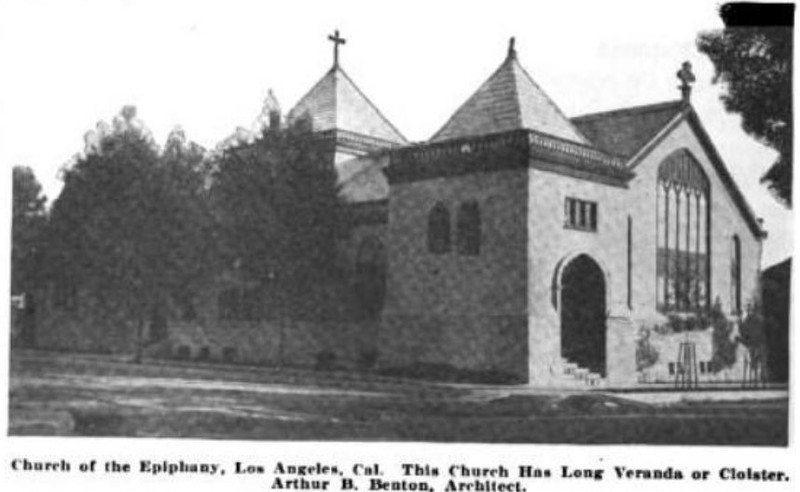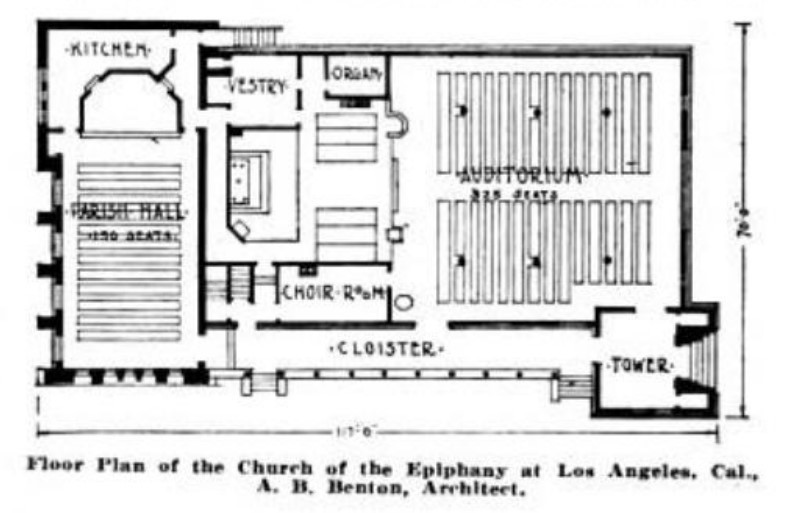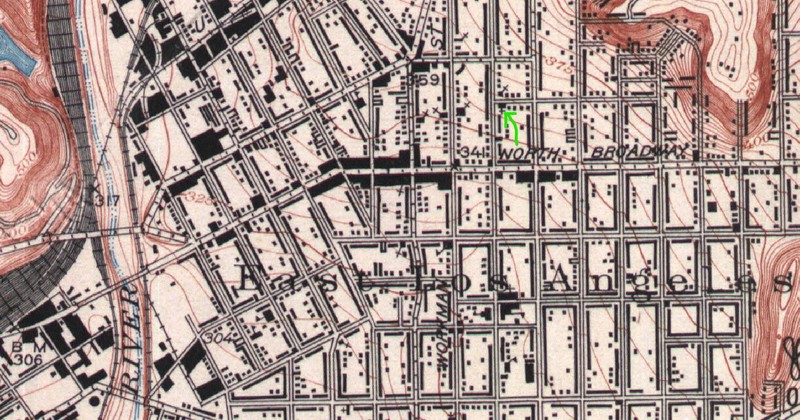Church of the Epiphany
Introduction
Text-to-speech Audio
This historic church is home to the oldest operating Episcopal congregation in Los Angeles. The congregation was established in the late 1880s and outgrew the building they were using by the 1910s, leading to the decision to construct this new church which was completed in 1913. The old structure was incorporated into the new church and became the parish hall. Church of the Epiphany became a center of Latino activism in the 1960s; a newspaper named La Raza was published in its basement. Labor leader Cesar Chavez, a champion of farm workers' rights in the 1960s and 1970s, spoke at this church. The Church of the Epiphany became a City of Los Angeles Historic-Cultural Monument in 2005 and was listed in the National Register of Historic Places in 2019. A restoration project began on the active church building in 2021.
Images
Photo of Church of the Epiphany from 1916 architectural magazine article by C.A. Byers

Sketch of first floor plan of Church of the Epiphany from 1916 architectural magazine article (Byers)

Church of the Epiphany (green arrow) in East Los Angeles area on 1928 topographic map (U.S. Geological Survey)

Backstory and Context
Text-to-speech Audio
The Church of the Epiphany in Lincoln Heights has the oldest operating Episcopal congregation in Los Angeles. They were actually the second oldest Episcopal congregation in the city, after the now-defunct St. Paul's parish. Church of the Epiphany was organized at a meeting held at the home of Mr. E.P. Cornick on January 6th, 1886. January 6th is the holy day of the Epiphany and the inspiration for the church's name. Reverend Henry Scott Jefferys was their first pastor. He resigned to go to Japan for missionary work in January 1888.
Ernest Coxhead designed the original church building for this site in the style of an English country church; it was not finished until 1888. The pastor by then was Rev. Charles A. Kienzle, who served until 1893. The 1888 church building was intended to be a secondary building, but,due to a shortage of funds, the congregation used the 1888 building as their first church. There was no permanent pastor for a couple years until Rev. A.G.L. Trew accepted the position in 1895. The congregation numbered 120 in 1896 and was still in debt for construction costs. The building was already outgrown by the early 1900s and a new church structure was being planned. The architect was Arthur Benton; he used a mixture of architectural revival styles - Gothic, Mission, and Romanesque. By December 1905, the architectural plans had been accepted and the first $1,000 of the predicted $8,000 costs had been raised. Speaking in January 1906 at his two-year anniversary of becoming pastor of Church of the Epiphany, the Reverend Walton Hall Doggett urged the growing and prosperous congregation to build the new church. The new church was attached to the old church and was finished in 1913. The old structure was incorporated into one end of the new church and became the parish hall. The interior of the new church is wood Gothic style with pillars and arches constructed of sturdy redwood. By 1915, the rector was Rev. William Bedford-Jones.
Church of the Epiphany has a history of support for social causes and has been called the "birthplace of the Chicano Movement." The neighborhood population became increasingly Latino in the mid-twentieth century. Fathers John Luce and Roger Wood headed the church in the 1960s and 1970s. Luce was hired because he had been trained as an organizer. The Brown Berets, a Chicano activist organization who protested against social injustices, got their start at this church. The Chicano activist newspaper La Raza was first published from the basement of the church in 1967 by Eliezer Risco and Ruth Robinson; it became a magazine in 1970 and was published until 1977. In 1968, Bobby Kennedy's campaign used the church as his East L.A. headquarters during the presidential primary. Labor leader Cesar Chavez, who became a champion of migrant farm workers' rights in the 1960s and 1970s and founded Farm Workers of America, spoke in this church. The church also became known for its support of Indigenous cultures.
Father Tomas Carey is the Vicar of Church of the Epiphany. The neighborhood still has a high concentration of immigrants from Latin American countries. Church clergy have continued to support activism and have participated in Black Lives Matter protests and union efforts for hazard pay for grocery workers. Meals cooked in their on-site kitchens are delivered to those in need; the church also runs a food bank and thrift shop. The Epiphany Conservation Trust has been raising funds for the restoration, anticipated to cost a million dollars. Major concerns are a leaking and crumbling basement and a leaking roof. Meeting rooms for the health care and legal clinics that serve the local community from the church are part of the improvements planned, as well as an upgrade of the heating/cooling system. Repairs began in January 2021.
Sources
Anonymous. "Yesterday at the Churches...Anniversary at Epiphany." The Herald (Los Angeles) January 6th, 1896. , 8-8.
Anonymous. "Plan Christmas for the Poor." Los Angeles Herald (Los Angeles) December 15th, 1905. 5-5.
Anonymous. "Gives Thanks; Takes Courage." Los Angeles Herald (Los Angeles) January 8th, 1906. 9-9.
Anonymous. Directory of Parishes and Missions (With Clergy) in the City of Los Angeles. Journal of the Twentieth Annual Convention of the Church in the Diocese of Los Angeles. January 1st, 1915. 227 - 230.
Byers, Charles Alma. An Episcopal Church Design. American Builder. January 1st, 1916. 72 - 72.
Carey, Thomas. Epiphany !Ahora!, GoFundMe Fundraiser for Epiphany Conservation Trust. January 27th, 2021. Accessed March 29th, 2023. https://www.gofundme.com/f/sxv66-epiphany-ahora.
Cesar Chavez: American Civil Rights Activist. History Channel. Performed by Marc Grossman and Carol J. Williams. United States. 2016. YouTube.
Episcopal Diocese of Los Angeles. La Iglesia de la Epiphania/Church of the Epiphany, Episcopal Diocese of Los Angeles. Accessed March 29th, 2023. https://epiphany.ladiocese.org/.
Gelt, Jessica. "This Church was Vital for L.A.'s Chicano Movement...." Los Angeles Times (Los Angeles) January 28th, 2021. Entertainment & Arts sec.
La gente y The Church of the Epiphany. Perez, Michael. Performed by Rev. Thomas Carey and Rosalio Munoz. United States. 2021. YouTube video.
Los Angeles Conservancy. Church of the Epiphany, Locations. January 1st, 2020. Accessed March 22nd, 2023. https://www.laconservancy.org/locations/church-epiphany.
Los Angeles Almanac. LA Raza - Documenting a Tumultuous Movement and an Overlooked Los Angeles Community, Los Angeles Almanac. January 1st, 2023. Accessed March 30th, 2023. http://www.laalmanac.com/media/me04m.php.
1916 issue of American Builder magazine (Vol. 20 p. 72)
1916 issue of American Builder magazine (Vol. 20 p. 72)
Calif. State U. Chico Digital Collections: Los Angeles quadrangle map, USGS 1928: http://archives.csuchico.edu/digital/collection/coll28/id/880/rec/765
